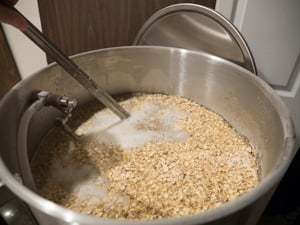This week I take a look at homebrewing in the modern era, how it has developed and the impact of technology on brewing.
A Quick History of Modern Homebrewing
While brewing beer at home has been done for many thousands of years, the modern history of homebrewing in the US has some clearly defined dates: October 14th, 1978 which is when President Carter signed HR 1337 legalizing homebrewing again in the US, and February 1st 1979 which is when the new law took effect.
Prior to that, the 18th amendment establishing Prohibition on Jan 16th, 1919 had shut down homebrewing for 60 years. Even when the 21st amendment to the Constitution repealed Prohibition, the associated legislation left out home beer making (though wine was legalized) so it was illegal to brew beer at home.
Many states also prohibited home brewing until July 1st 2013, when Mississippi became the last state to legalize homebrewing.
The Early Days of Modern Homebrewing
I started brewing beer at home in early 1987, and while the hobby was expanding rapidly at that time the quality of ingredients and body of knowledge was quite poor. The majority of brewers at the time were extract brewers, and the extracts and malts we worked with were often packaged overseas and not properly handled during their long voyage to the US. Yeast was often variations of dry bread yeast packets, and we used whole hops that were packaged in plastic bags and stored on open shelves rather than frozen or refrigerated.
We had a handful of books to work with including the first edition Joy of Homebrewing by Charlie Papazian, but recipes were often vague listing 2 oz of boil hops but not a boil time for instance. The average homebrewer had no knowledge of how to estimate color, bitterness or even original gravity or even how to properly calculate infusion temperatures for all grain brewing.
A lot of bad beer was made, but we persevered often because we could make beer styles that were commercially unavailable at the time.
The Early 1990’s
The 1990’s brought about a renaissance in both craft brewing and home brewing. The first wave of craft breweries began to pop up in significant numbers, introducing US beer drinkers to styles beyond pale American lager. Ingredients improved significantly as the first yeast labs began producing high quality liquid yeast for virtually any beer style. Homebrewers gained wide access to pelletized hops that were properly packaged and stored in oxygen barrier packaging. A wide variety of grains and adjuncts became available and several popular mail order home brew shops gave broad access to homebrew supplies.
Knowledge also exploded. Homebrewers gained access to some of the latest research including work by Tinseth, Garetz and Rager on how to estimate bitterness in beer. The Morey equation gave us a more reliable estimate of color for beer. Brewers figured out how to properly calculate infusion temperatures and all grain brewing expanded greatly during this time.
The Rise of the Internet and the Impact on Home Brewing
As both the availability of ingredients and knowledge exploded in the early 1990’s we also saw the dawn of digital communications starting with the ARPA net, bulletin boards in the late 1980’s, large services like Compuserve and several very important home brewing news groups. By the mid-1990’s the internet browser entered the scene and knowledge sharing expanded further. All of this knowledge drove not only the first large wave of homebrewing but also the first large wave of Craft Brewing in the US throughout the 1990’s. We also saw the first crash, both in homebrewing and craft breweries around the time that the dot-com bubble burst in the late 1990’s.
Consequences of the Internet Homebrewing Rennaissance.
One important feature of the explosion of digital knowledge continues to this day. The pre-internet and early internet was dominated by scientists and engineers, who quite simply were the first ones who had access to the networks and technology. As a result it was the scientists and engineers who dominated the early discussion on homebrewing and drove the bulk of techniques we use today.
While this has been a great thing for both homebrewers and craft brewers, it has also driven home brewing along a more technical track than traditional pursuits like wine making. Home brewers are focused heavily on the technical aspects of brewing from basic things like calculating IBUs to more advanced topics like adjusting mash pH or building exotic water profiles.
Moving Beyond the Technical
In several live presentations recently, I’ve expressed my concern over this trend. While it is important to get the technical aspects of brewing right, I do sometimes get concerned that the focus of brewing has become too technical at times and that we often lose sight of the more important aspects of brewing like what flavors we’re adding to the beer and how those flavors interact to produce a complete beer experience.
Brewing beer is a mix of both science and art, and some of the most refreshing discussions I have with fellow brewers are about flavors, aromas, unique ingredient combinations and creating beers that are outside the norm. So I encourage you, as brewers, to explore the ingredients you brew with, the flavors and aromas they provide, how those flavors interact and even the serving, tasting and drinking experience. Get in touch with the artistry of brewing and not just the numbers.
I hope you enjoyed this week’s article from the BeerSmith Home Brewing Blog. Please subscribe for regular weekly delivery, and don’t hesitate to leave a comment or send this article to a friend.
